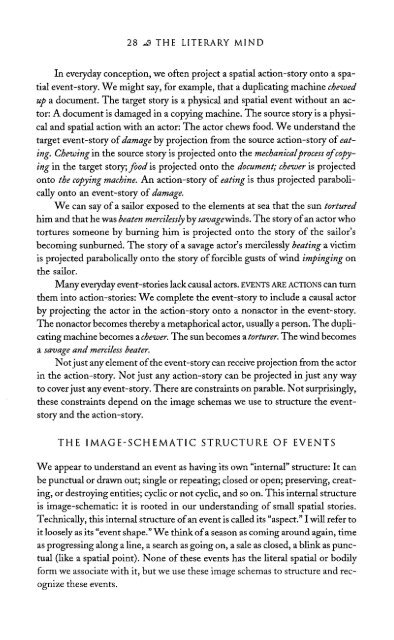The Literary Mind.pdf
The Literary Mind.pdf
The Literary Mind.pdf
Create successful ePaper yourself
Turn your PDF publications into a flip-book with our unique Google optimized e-Paper software.
28 THE LITERARY MIND<br />
In everyday conception, we often project a spatial action-story onto a spatial<br />
event-story. We might say, for example, that a duplicating machine chewed<br />
up a document. <strong>The</strong> target story is a physical and spatial event without an actor:<br />
A document is damaged in a copying machine. <strong>The</strong> source story is a physical<br />
and spatial action with an actor: <strong>The</strong> actor chews food. We understand the<br />
target event-story of damage by projection from the source action-story of eating.<br />
Chewing in the source story is projected onto the mechanical process of copying<br />
in the target story; food is projected onto the document; chewer is projected<br />
onto the copying machine. An action-story of eating is thus projected parabolically<br />
onto an event-story of damage.<br />
We can say of a sailor exposed to the elements at sea that the sun tortured<br />
him and that he was beaten mercilessly by savage winds. <strong>The</strong> story of an actor who<br />
tortures someone by burning him is projected onto the story of the sailor's<br />
becoming sunburned. <strong>The</strong> story of a savage actor's mercilessly beating a victim<br />
is projected parabolically onto the story of forcible gusts of wind impinging on<br />
the sailor.<br />
Many everyday event-stories lack causal actors. EVENTS ARE ACTIONS can turn<br />
them into action-stories: We complete the event-story to include a causal actor<br />
by projecting the actor in the action-story onto a nonactor in the event-story.<br />
<strong>The</strong> nonactor becomes thereby a metaphorical actor, usually a person. <strong>The</strong> duplicating<br />
machine becomes a chewer. <strong>The</strong> sun becomes a torturer. <strong>The</strong> wind becomes<br />
a savage and merciless beater.<br />
Not just any element of the event-story can receive projection from the actor<br />
in the action-story. Not just any action-story can be projected in just any way<br />
to cover just any event-story. <strong>The</strong>re are constraints on parable. Not surprisingly,<br />
these constraints depend on the image schemas we use to structure the eventstory<br />
and the action-story.<br />
THE IMAGE-SCHEMATIC STRUCTURE OF EVENTS<br />
We appear to understand an event as having its own "internal" structure: It can<br />
be punctual or drawn out; single or repeating; closed or open; preserving, creating,<br />
or destroying entities; cyclic or not cyclic, and so on. This internal structure<br />
is image-schematic: it is rooted in our understanding of small spatial stories.<br />
Technically, this internal structure of an event is called its "aspect." I will refer to<br />
it loosely as its "event shape." We think of a season as coming around again, time<br />
as progressing along a line, a search as going on, a sale as closed, a blink as punctual<br />
(like a spatial point). None of these events has the literal spatial or bodily<br />
form we associate with it, but we use these image schemas to structure and recognize<br />
these events.















